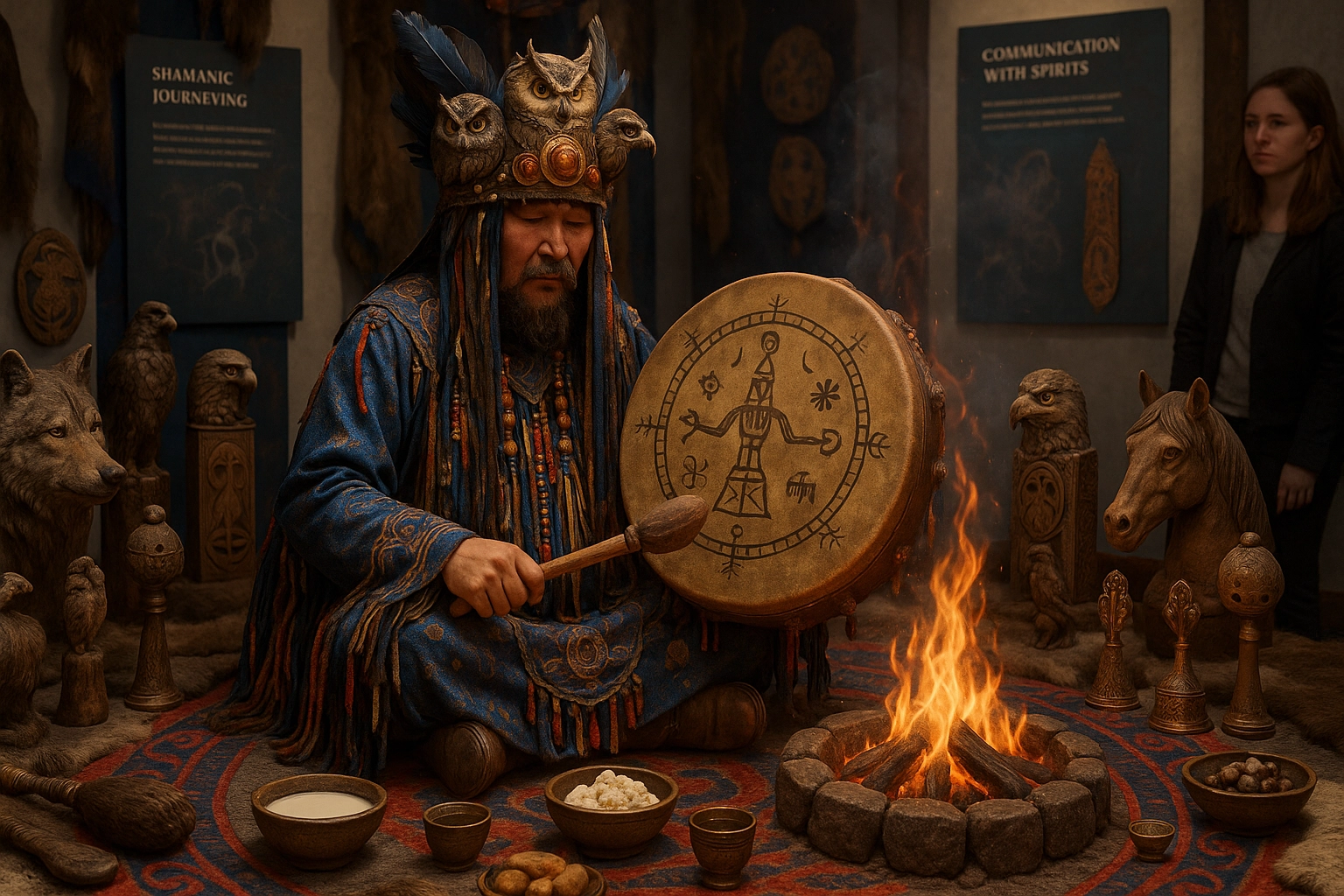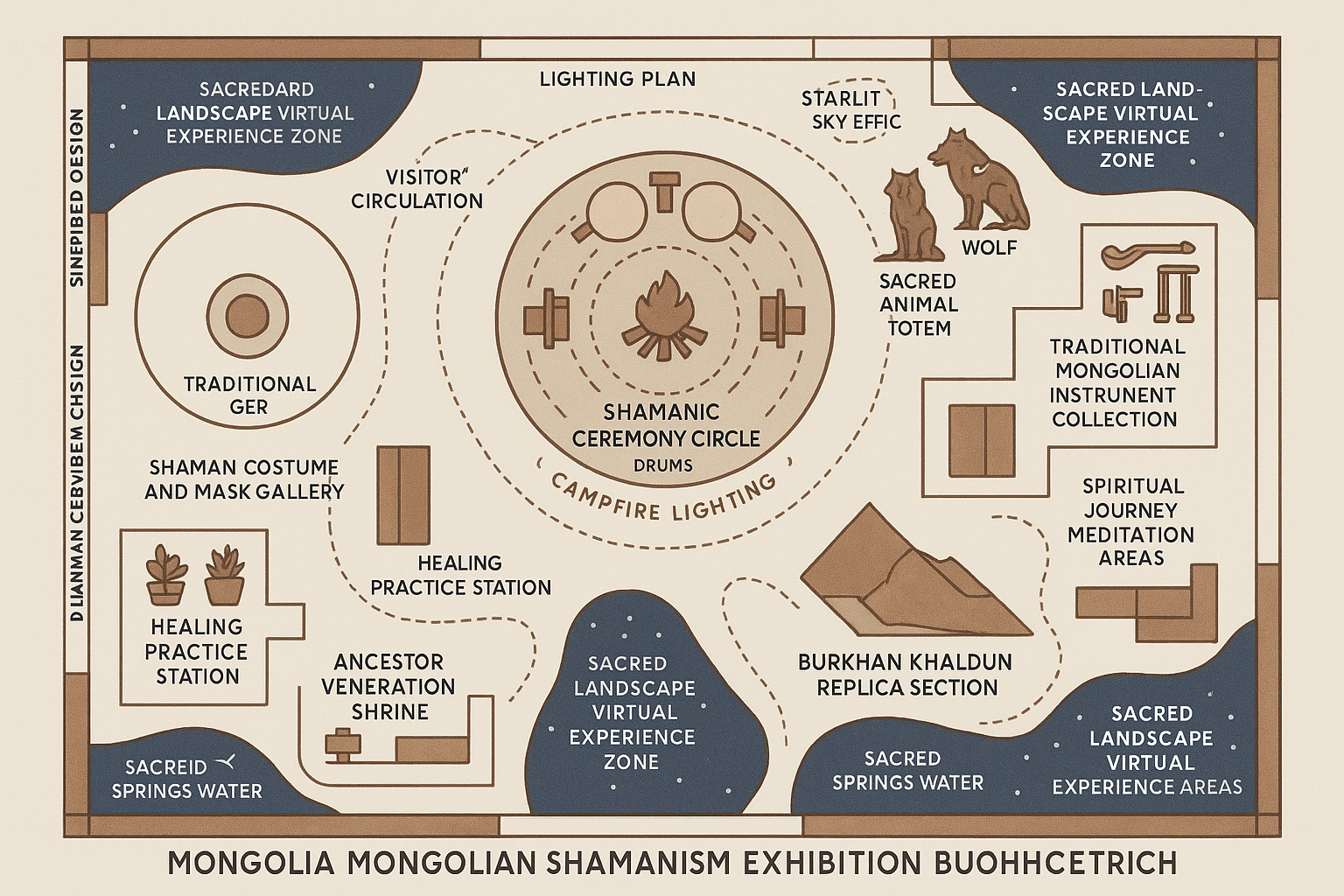Mongolian Shamanism Exhibition
Discover the ancient spiritual traditions and profound wisdom of Mongolian Shamanism through our immersive exhibition experience
Exhibition Layout & Experience

Exhibition Floor Plan
Interactive layout showcasing shamanic ritual areas, sacred ovoo spaces, and traditional ger displays

Main Exhibition Hall
Featuring shamanic drums, ceremonial costumes, and sacred artifacts from the Mongolian steppe

Sacred Sky Worship
Immersive display honoring Tengri, the Eternal Blue Sky, with traditional offerings and ceremonies
Historical Origins
Mongolian shamanism is one of humanity's most ancient spiritual traditions, with roots tracing back at least 5,000 years to the early nomadic societies of the Eurasian steppe. It developed as a nature-based system of spiritual knowledge, shaped by the vast Mongolian landscape and deep reverence for Tengri, the Eternal Blue Sky.
Formation & Development
Shamanism evolved among nomadic clans as sacred communication with nature spirits and ancestors. The tradition flourished among Turkic and Mongolic tribes, becoming the foundational worldview of the Mongol Empire under Genghis Khan, who attributed his authority to the sky deity Tengri.
Key Figures & Leaders
Shamans (Böö, Udgan)
Spiritual leaders who journey between worlds, perform healing, and guide communities.
Genghis Khan (Chinggis Khaan)
Revered as semi-divine ancestor, unifier of Mongolia, and legendary shamanic figure.
Ancestral Spirits
Deceased elders and clan founders venerated for guidance and protection.
Core Concepts & Beliefs
Tengriism
Worship of Tengri, the Eternal Blue Sky, as supreme cosmic power.
Three Worlds Cosmology
Upper, Middle, and Lower realms connected by the World Tree.
Animism
All nature elements inhabited by spirits and ancestor veneration.
Spirit Communication
Shamans mediate through drumming, trance, and offerings.
Fundamental Principles
Harmony with Nature
Living in balance with spirit world and natural forces.
Ancestral Respect
Honoring clan spirits and family lineages as spiritual chains.
Community Wellbeing
Collective harmony over individual desires.
Cyclical Time
Seasonal renewal and natural cycles of existence.
Sacred Symbols
Shamanic Drum (Tovshuur)
Instrument for trance and spiritual travel between worlds.
Ovoo (Stone Cairn)
Sacred markers connecting earth and sky at holy places.
Wolf, Eagle, Horse
Primary animal totems symbolizing protection, vision, and travel.
Blue Scarf (Khadag)
Symbol of Tengri and offering of respect to spirits.
Major Rites & Ceremonies
Shamanic Ceremony
Drumming, chanting, and spirit invocation within sacred circles.
Ancestor Offerings
Milk, airag, and food presented at family altars or ovoos.
Healing Rituals
Soul retrieval, energy balancing, and removal of spiritual curses.
Seasonal Festivals
Tsagaan Sar, summer solstice, and harvest celebrations.
Global Influence & Cultural Impact
Living Heritage
Mongolian shamanism is the living spiritual heritage of Mongols and Buryats, influencing cultures across Central Asia and experiencing revival after Soviet repression as a symbol of national identity.
Cultural Foundation
Shamanism shaped Mongolian customs, folklore, art, and statecraft—most notably the divine mandate claimed by Genghis Khan. Its worldview underpins respect for nature and community cohesion.
Geographic Reach
Practiced throughout Mongolia, Inner Mongolia, and among Siberian peoples. Sacred mountains, steppe ovoos, and river sites spread across the region with major centers in Ulaanbaatar and Lake Baikal.
Important Spiritual Texts & Traditions
Oral Tradition
Knowledge transmitted through lineage and ritual practices
Secret History of the Mongols
13th century epic mixing history and shamanic legend
Epic Tales and Genealogies
Stories recited by shamans preserving ancestral wisdom
Sacred Places & Monuments
Burkhan Khaldun
Most sacred mountain, associated with Genghis Khan and the World Tree
Ovoos
Stone cairns on hilltops, passes, and riverbanks
Sacred Springs
Sites of ritual purification and blessing ceremonies
Traditional Gers
Ceremonial and everyday spiritual centers of nomadic life
Memorable Teaching
"He who forgets his ancestors is like a river without a source, a tree without roots."— Mongolian Proverb